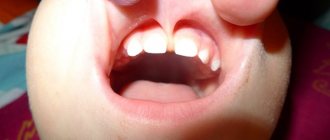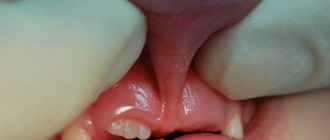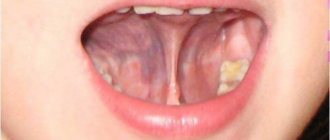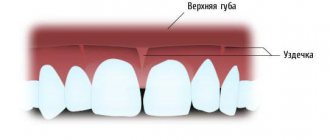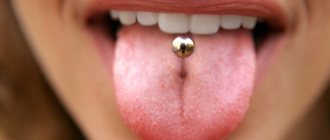Short frenulum of the tongue - parents encounter this problem around the time their baby turns 3-4 years old. He has been trying to speak for a long time, knows a lot of words, knows how to construct complex phrases, but does not pronounce some words accurately.
Grandmothers assure that in another year the child will “speak out”; mothers work with their children using special methods for early development, but the problem is not solved. If your child is still babbling at 4 years old, it is time to visit the pediatric dentist.
The frenulum of the tongue externally resembles a thin membrane, consisting mainly of connective tissue, the function of which is to attach the tongue to the bottom of the oral cavity.
In other words, a short frenulum of the tongue in a child is some kind of defect in the oral cavity that interferes with the joint movement of the tongue.
In some cases, the frenulum does not look thin at all, which significantly aggravates the situation. Almost half of all parents face this problem. And although a short frenulum can be noticed by a specialist even in newborns, parents learn about it when the baby begins to talk.
Pathology of the frenulum of the tongue can be congenital and hereditary. It should be understood that these concepts are completely different. If a congenital pathology is already present at birth, then a hereditary pathology is most often already present in one of the family members.
The concepts of complete and partial short frenulum of the tongue in a child are also distinguished. The level of discomfort of the child and the type of treatment chosen (surgical intervention or corrective exercises) depend on the type of pathology.
With a full frenulum, the child's tongue is practically immobilized, which makes it much more difficult to pronounce most speech sounds. With this type of pathology, muscle cords form. In the case of partial pathology of the frenulum of the tongue, the role of muscle cords is performed by connective tissue.
Tongue frenulum
It is located on its lower surface. When the tongue is raised upward, the frenulum seems to hold it. It is located in the middle of the organ and connects the mucous membrane to the floor of the oral cavity. The length of the frenulum in an adult, as a rule, does not exceed three cm. Its parameters and location do not interfere with the movement of the organ in most people.
There are cases when the upper part of the frenulum is located almost at the very tip of the tongue. If you try to lift it, it takes the form of a groove, and the fold of skin becomes tense and causes discomfort. In addition, if you stick out your tongue, it will hardly even half cover your lower lip, and its tip will point down. Although the length of the frenulum may be within normal limits, from a medical point of view it is considered short.
For some people it really is this way - no more than 1.7 cm. If it is located correctly, then this length does not affect the functioning of the tongue in any way. Below in the photo is a frenulum of the tongue of an infant, which is considered short by medical standards. In this case, surgical cutting is indicated.
Prevention
It is impossible to prevent congenital pathology, but it is not difficult to avoid subsequent complications. Recommended:
- undergo regular examinations by a urologist to ensure timely detection and treatment of problems;
- if an uncomfortable frenulum length is detected, correct it as soon as possible;
- wear comfortable underwear made of breathable fabric;
- use special lubricant during sex;
- avoid traumatic poses, too sharp frictions;
- if there is no sexual partner, be careful when masturbating;
- keep the penis clean;
- At the first symptoms of genitourinary infections, seek medical help.
In addition, it is very important to be attentive to any unpleasant sensations during puberty (12-18 years), when the frenulum may “lag behind” the growth of the penis and can be easily damaged.
Frenum of the upper and lower lips
In the human oral cavity there are 2 more folds of skin. They serve as an additional attachment of the lips to the jaws.
The frenulum of the upper lip is a fold located vertically. According to its structure, it is of the following types:
- Mucous. Outwardly, it resembles a thin film that stretches very well.
- Fibrous. The fold is very tight and practically does not stretch.
- Muco-fibrous. In this case, they speak of an average degree of density and extensibility of the upper frenulum.
In addition, it is classified by attachment height:
- Low. The fold passes directly into the gingival papilla.
- Average. Located in the middle of the gum.
- High. It is located in the transitional fold of the upper lip.
It is considered normal if the lower connection of the lip frenulum is located at a distance of approximately 5 mm from the neck of the anterior incisors. If it is located lower or even goes behind the teeth, then the fold is considered shortened.
The lower frenulum is located deep in the area between the gum and the inside of the lip. Normally, it is a thin, barely noticeable film. Its difference from the frenulum of the upper lip is also that it should not be attached to the gingival papilla. Otherwise, correction of the fold is indicated to avoid the appearance of speech defects. As a rule, its abnormal location is detected soon after birth. The correction is carried out surgically, after which the film does not affect the development of the child’s speech in any way.
Foreskin
The frenulum of the foreskin is the most important element of the male penis. It ensures the normal functioning of the reproductive system, protecting the reproductive organ from pathogenic microorganisms and external influences. It has a high degree of elasticity, due to which during an erection the head of the penis is exposed, and when its blood supply decreases, it is covered by the foreskin.
Every man should know that the frenulum is a formation of skin, the developmental anomalies of which negatively affect both sexual life and health:
- every sexual intercourse becomes painful;
- ejaculation occurs prematurely;
- the penis gradually becomes curved.
Against the background of these disorders, almost every man develops psycho-emotional disorders.
From an anatomical point of view, the frenulum on the head of the penis is a fold that forms a kind of membrane that connects the lower part of the penis and the foreskin. It performs not only a protective function. The frenulum is also a powerful erogenous zone, which directly affects the duration of sexual intercourse and the sensations during ejaculation.
Inside the fold there is a huge number of vessels and nerve endings, due to which any injury or disease in this area is accompanied by pain and other unpleasant symptoms, as well as psychological discomfort. Ignoring warning signs can lead to serious consequences, and therefore you should consult a doctor the first time they appear.
At what age is it better to have frenuloplasty?
The sooner an anomaly in the shape and structure of the frenulum is identified, the more painless the operation to correct it will be. Accordingly, there will be many times fewer unpleasant consequences for the body.
- infancy: this is the best option. The pathology is usually diagnosed in the maternity hospital during examination of the newborn. At the age of up to 9 months, the membrane of the tongue has not yet had time to acquire blood vessels and does not have nerve endings, which means that the procedure for its correction will be quick and painless. The baby will almost immediately begin to eat well and stop being capricious. In children who have undergone frenuloplasty before one year of age, their appetite is quickly restored, since the sucking reflex is not impaired,
- 1-3 years: this period is the best time to visit the dentist for the first time; he will be the one who will be able to diagnose the problem and take action. Trimming the frenulum at this age will also be quite painless and will not harm the jaw system,
- 5-8 years: if the pathology of the frenulum was not resolved at an earlier age, then this can be done when the baby teeth fall out, but it is better before the baby teeth are replaced with permanent ones. A specialist needs no more than ten minutes to eliminate the pathology. But it is worth noting that at this age the child can already speak, which means he will have to additionally visit a speech therapist to retrain the baby to pronounce a number of sounds.
Correction of the frenulum related to the tongue
As a rule, a shortened fold of skin is detected in newborn children already in the maternity hospital or during the first examination by a pediatrician. In the first months of life, a child’s frenulum is a thin film-like frenulum that does not have blood vessels. In this regard, it is cut by the dentist with scissors or a scalpel. During this manipulation, the newborn does not feel pain, and after cutting it is immediately applied to the mother’s breast.
Ignoring the presence of a short frenulum in a child leads to various disorders:
- improper and poor quality milk sucking;
- slight weight gain (below normal);
- early refusal of the mother's breast;
- retardation in physical and psychological development.
In older children and adults, the frenulum is a dense area with a large number of vessels, and therefore its plastic surgery is indicated. As a rule, pathology is detected when visiting a dentist or speech therapist.
Signs of a short frenulum are:
- low degree of tongue mobility;
- difficulty pronouncing whistling, hissing and palatal sounds;
- inability to reach the upper incisors with the tip of the organ;
- The tongue cannot be stuck out completely.
From a medical point of view, indications for frenulum correction are:
- speech disorders;
- impaired growth of the lower jaw;
- the need to use orthodontic structures.
Like any other surgical treatment, cutting the frenulum has a number of contraindications. It is not performed if the patient has:
- Oncological diseases.
- Blood pathologies.
- Inflammatory processes in the oral cavity.
- Infectious diseases in the acute stage.
The operation is performed using a scalpel or surgical laser under local anesthesia. In the first case, after completion of the plastic surgery, self-absorbing sutures are applied, in the second, there is no need to use them. After the operation, the patient must treat the oral cavity with an antiseptic solution after each meal for a week.
Treatment methods
Problems associated with a short frenulum of the tongue can be solved with medicinal and non-medicinal methods.
Medicinal methods involve surgical intervention of varying degrees.
If the sublingual membrane requires dissection, but it is quite thin and elastic, then the doctor dissects it right at the appointment. In this case, anesthesia is not provided, since the procedure is classified as mild.
More complex types of dissection of the frenulum of the tongue include frenulotomy, which is indicated for children with thicker frenulums. Frenulotomy is performed under local anesthesia with tissue dissection and subsequent suturing.
Complications of this operation may include stomatitis, prolonged bleeding from the wound, infection in the wound, etc. After frenulotomy, the child should receive pureed food for some time, as chewing may be painful.
Non-drug treatment methods include special types of massage, exercises to correct the frenulum of the tongue, and individual sessions with a speech therapist.
Non-drug methods are recommended when the condition of the child’s tongue frenulum is not critical and allows refusal of surgery. The decision on this is made by a speech therapist, pediatrician and dentist. Classes with a speech therapist include various exercises, articulation gymnastics, tongue twisters and poems.
Since a short frenulum of the tongue causes some speech defects, classes with a speech therapist are necessary both in the postoperative period and as a correction.
A massage aimed at stretching the frenulum of the tongue includes a list of special exercises. It is important that the classes are systematic so that they give a positive result.
Massage instead of cutting the frenulum is recommended for children in two cases: if the condition of the frenulum is not so critical and the problem can be solved with non-drug treatment methods; if the frenulum is cut when the child is older (over 5 years old) and the surgery will not solve problems with speech impediment.
Penile frenulum correction
Abnormal fold length can be either congenital or acquired as a result of various injuries.
If a short frenulum is detected in childhood, the doctor recommends trimming it to avoid possible problems in the future. In adult men, the pathology leads to various disturbances in sexual life, and therefore you should consult a doctor if pain and discomfort occurs during sexual intercourse. It is important to understand that the frenulum of the penis is such an important element, developmental anomalies of which can even lead to erectile dysfunction.
Correction is carried out surgically. Its duration, as a rule, does not exceed 20 minutes, and the patient is not required to follow any preparation rules.
Before the intervention begins, doctors carefully clean the man’s/boy’s genitals and administer anesthesia. Intravenous injection is indicated for children under 12 years of age. For adults, the drug is injected into the skin of the penis.
The operation is performed using a scalpel. Upon completion, a gauze pad is applied to the penis, the patient receives instructions regarding subsequent wound care, after which he can immediately begin his daily activities.
Why and how does it tear?
The bridle has great potential for stretching, as its structure is dense and elastic. However, there are pathologies in which the elasticity of the frenulum is reduced or it is too short. Therefore, during intense sexual intercourse, it may not withstand the tension and it breaks.
It is impossible to predict a frenulum tear. A shortened frenulum is no different in appearance from a normal one. Therefore, at the birth of a child, it is impossible to determine that the frenulum is short.
Why does this part of the body tear and hurt? The reasons may be as follows:
- sudden and rough movements during masturbation;
- repeated tearing that occurred during the formation of scar tissue;
- frenulum is too short (congenital pathology);
- vaginal dryness of the partner;
- defloration.
When the frenulum is torn, the man feels pain (usually mild), heavy bleeding appears, and the foreskin decreases in size. All this leads to severe discomfort.
What to do if the frenulum ruptures?
Mostly, the folds located in the oral cavity and on the male penis are susceptible to injury. If there is a rupture of the frenulum under the tongue or the upper/lower lip, the wound must be treated with hydrogen peroxide. You should see a doctor as soon as possible, especially if the injury occurred in a child.
The greatest danger is rupture of the folds on the penis. It can happen for various reasons, but, as a rule, it happens during sexual intercourse.
Rupture is always accompanied by severe bleeding and severe pain. The procedure for dealing with an injury is as follows:
- The frenulum should be pressed tightly against the head for about 10 minutes. During this time, you cannot remove your fingers from the penis. There is no need to squeeze the organ too much; this can lead to poor circulation in the head.
- After the specified time, carefully remove your fingers. If the bleeding has stopped, you need to treat the wound with any antiseptic and apply a bandage. It should only cover the affected area, but in no case should it squeeze the penis.
At the first opportunity, you need to see a doctor and get plastic surgery. Not everyone understands that the frenulum is an area that, after the first injury, is highly likely to rupture again.
Specifics of procedures with a bridle
The type of medical measures to restore normal functionality of the penis depends on the type and severity of the pathology.
The decision on the need for a particular procedure is made by a doctor (urologist or surgeon) after an examination.
Elongation
A short frenulum not only causes discomfort, but also breaks easily, so it is important to restore normal length and elasticity as soon as possible. Treatment of the pathology is surgical, but there is no need to be afraid or postpone the operation: the entire procedure takes less than half an hour, is performed under local anesthesia, and recovery will take about two weeks.
Most often, cutting (frenulotomy) of the frenulum is prescribed; sometimes they resort to VY-plasty, during which the doctor makes one or several incisions in the shape of a Latin V, after which he sews the bottom of the incision, forming something like the letter Y. This method requires longer rehabilitation and often leaves noticeable scars, which for some men is unacceptable.
After any lengthening surgery, you must abstain from sex for at least 4 weeks, follow all doctor’s recommendations, and minimize physical activity. In the first days, the greatest pain and swelling is observed; daily dressings and treatment of the postoperative wound with the means prescribed by the doctor are required.
Trimming
The most popular procedure for increasing the length of the frenulum. In simple cases it only takes 2 steps:
- A transverse incision in a skin fold.
- Stretching it lengthwise.
- Application of longitudinal sutures along the resulting wound.
If the frenulum has previously torn and healed incorrectly, forming a rough scar, the operation is complicated - the surgeon has to excise the altered tissue, and then also stitch it in a direction parallel to the growth of the penis.
Trimming is the preferred procedure because healing is rapid and scars are barely noticeable. It is possible to dissect tissue with various instruments:
- with a scalpel - blood loss is noted, but the sutures are most accurate;
- radio knife - high-frequency radio waves affect the skin, preventing the formation of a hematoma or infection;
- laser - the operation is bloodless, but cauterization creates rougher scars, which can subsequently diverge.
With proper care after pruning, there are no complications.
Delete or Trim
Frenumplasty is not always effective. Why complete removal of the skin cord may be necessary:
- phimosis (narrowing of the foreskin, making it difficult or impossible to open the head);
- severe injury to the frenulum or the presence of a large number of scars due to previous injuries;
- sclerosing pathologies in the foreskin area.
In addition, circumcision is possible at the request of a man, for religious or hygienic purposes.
It is important that removal of the skin fold can be carried out while preserving the foreskin or partial resection (although this does not make sense).
In adult men, the operation is performed under local anesthesia and lasts up to 1 hour. The surgeon carefully pulls back and trims excess skin, removes the frenulum, and applies self-absorbing sutures. Full recovery occurs within 30-60 days, during which time it is necessary to abstain from sexual activity and, if possible, avoid erections.
Which doctor should I contact?
If you are concerned about the location of the folds in your mouth, you should make an appointment with your dentist or surgeon. In most cases, they can trim the bridle the same day.
If the fold is torn or there are abnormalities in its development on the penis, you should contact a urologist.
Circumcision
This is a simple operation that can be of several types:
- Partial. The foreskin is preserved; the doctor removes only the damaged area, allowing the head to fully open.
- Average. A significant part of the tissue is excised, the remaining part forms a small fold, while the head opens completely.
- Tight. This is the most aesthetic option, in which a significant area of the skin is removed.
The surgical intervention can be carried out using radio waves, a disposable plastic ring, a laser, and a seamless operation is also practiced - a polymer absorbable film is used. After circumcision, it is necessary to moisturize the skin fold with special products and wash the penis with antiseptic solutions several times a day. This is necessary so that a rough scar does not form.


